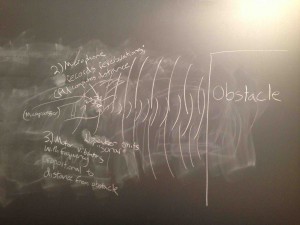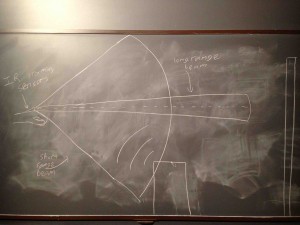Evan Strasnick, Xin Yang Yak, Jacob Simon, Joseph Bolling
Brainstorming!
- Dielectric stimulation – Choreography is hard to communicate and record, teach it to people by stimulating their bodies
- For anyone attempting to hobbies, sports, or arts requiring tacit skills (e.g. skiing), a helmet could record the motions and perspectives of the master, and then the apprentice could have this perspective played back for them as they attempt the motions.
- Dynamically adapting screen that uses eye tracking to take advantage of foveal resolution / peripheral resolution and thereby optimize resources and space.
- Glasses or some form of headpiece that tracks direction of gaze to turn on lights only where a person is currently looking, to conserve energy (or just a cool social experiment)
- Bad habits tracker: a basic app combined with select hardware pieces could allow users to select their personal bad habits and collect statistics on how often they occur, as well as give advice (teeth-grinding, snoring, stuttering, etc.).
- A patch containing a variety of flex sensors could be applied to any of a number of target areas on patients with bad posture, helping to remind them with simple vibration when they sink into unhealthy positions.
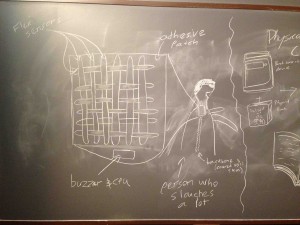
- A flex-sensor based device to be placed on the neck, that stimulates (vibration, dielectric, etc.) students with a tendency to fall asleep during class.
- Speech recognition software that reads the users lips (and applies predictive software) instead of listening to an audio stream would allow users in public locations to have text-to-speech input without having to speak to their computer, or could serve as an enhancement to existing audio-based software, or could serve as input for disabled/blind patients.
- Door that is gesture-triggered, not just motion-triggered – automatic doors often open even when passersby don’t intend to pass through the door; this could be fixed with a more nuanced interface
- An automatic toilet that will never flush while you’re still using it. (heat or pressure sensors)
- Integrating an accelerometer component into a watch or wedding ring, allowing users to respond to common prompts instantly and effortlessly (answering/rejecting calls, turning off reminders, etc.)
- An alarm that wakes you up using gradually increasing light rather than sound. This not only allows users to wake up more naturally and peacefully, but does not disturb neighbors/roommates.
- Track REM periods through eyelids to monitor quality and duration of sleep states.
- For anyone who wishes to check time discreetly during class, work, a meeting, etc: a ring, bracelet or other touch-controlled item that can signal with vibrations
- Sensors (pressure sensors, proximity sensors) that can be placed around the house to automate the tasks a user must perform in various locations (e.g. turn off lights when pressure in bed registered after a certain time, open blinds by stepping in front of them, etc.)
- A device which monitors basic physiological readings (blood pressure, heart rate), and activates severity-determined anxiety prevention steps (from helpful text messages to emergency personnel alerts) to help patients with phobias
- 3D TV must be viewed from a specific angle to reach the full effect. We propose glasses that use accelerometers or eye tracking to constantly adjust the TV to the correct viewing angle in real time.
- Playing cards visible only to players – each player wears glasses which overlay images on specialized cards currently being held in front of them; other players are not shown these images.
- Splitscreen multiplayer that is player-specific, hides other player’s screen
- A TV which allows family members to view different channels or programs at the same time, using polarized light and viewing glasses for example.
- For improved hygiene in public restrooms, an intelligent toilet that automatically raises or lowers its seat depending on user intention (penis identifier).
- Making it easier to observe shabbat by automating common tasks using passive proximity technology.
- New types of trackpads which can distinguish and recognize individual fingers for advanced gestures – Modern trackpads are very accurate, but cannot identify which finger is being used; doing so would allow for much more nuanced interactions, shortcuts, etc. with a computer.
- Car safety (warning if you don’t check your mirrors and blind spots) – eye tracking software could be used to train new drivers to check their blindspots, one of the harder things to learn when driving.
- Phone mouse using visual and accelerometer input – The camera on a modern smartphone could be used with accelerometer data to let users accurately pan onscreen by moving their phone.
- Actively heated clothing – Clothing that is actively heated by warmed fluids or another mechanism would maintain body temperature in extremities during winter without adding too much bulk, and could be made smart through temperature sensors and shiver-detection.
- Study space noise tracker – It’s difficult to know which public spaces on campus are being used as social areas and which are available for quiet study at any given moment; this could be fixed with noise sensors and a web application.
- Dance-based music selection – We could solve the problem of poor party DJ-ing with a system that recognized the dances different dancers are performing and selects songs accordingly.
- Dance-controlled music synthesizer – The improvised dance performance is vastly improved by live musicians. This device would produce a similar conversation between dancer and musician without the inconvenience of finding a live musician.
- Anti static phone charger – Harvesting the static electricity that builds up in clothing during winter could help charge small devices and solve a major annoyance.
- People who like to do gardening recreationally may not know what kinds of plants their garden soil/climate is suitable for. A device that monitors the soil and climate condition can help the planter figure out what types of plants are likely to do well in the garden.
- Dental sensors in dentures/retainers – Basic dental diagnostics such as bacterial populations, enamel health, and tooth position could be assessed using devices implanted in dentures and retainers
- Text input for severely disabled patients by touching their tongue to their teeth using a specialized retainer.
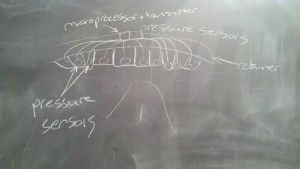
- A toothbrush that maps out where users reach (and don’t reach) while brushing, allowing them to improve their brushing habits and dental hygiene.
- Audiovisual recording buffer device – Allows you to retroactively record moments in your life or lecture by keeping a running buffer of the last few minutes. Allows users to never miss out on a moment of accidental hilarity, without the storage restraints of constantly recording the entire day
- Improve bad handwriting with a pen that actively corrects its user with counterbalanced weights.
- In some sports, it’s easier to spot bad form if you can see yourself in third-person view. Goggles that allow the athlete to see him/herself in third person while performing the action during athletic training might help to improve form.
- Monitoring the food that is being baked in the oven currently requires one to open the oven, but this reduces the oven temperature and requires that the chef always be nearby and alert. An oven camera which streams to a smartphone would allow constant monitoring without interfering with the baking.
- Smart microwave oven that both scans barcode of food and figures out how long to cook it, and also adjusts the microwaving plate using pressure sensors to always center food to cook evenly.
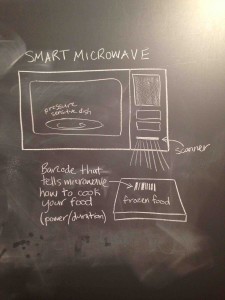
- It’s a hassle for hikers/athletes/patients who need to stick to a hydration plan to keep track of their fluid intake. A water bottle that tells you how much to drink would help.
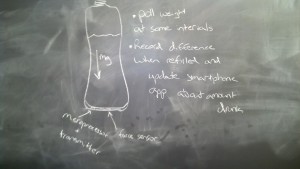
- CPR instructor necklace/tattoo – A device worn by populations at risk for cardiac arrest could indicate to untrained rescuers how and where to apply chest compressions for CPR.
- Phone EKG patch/heart monitor – People could keep continuous track of their cardiac health by wearing small electrode devices that would communicate warnings to a cellphone or other handheld interface.
- Weight-lifting sensor gloves – Gloves with built in pressure sensors and accelerometers could track and deliver statistics on how much work is being done with each arm, to allow weightlifters to more accurately exercise their muscles.
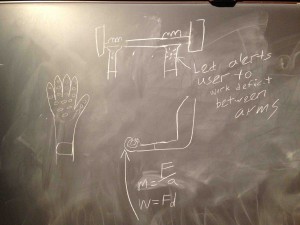
- Customer heatmap for stores/attractions – A manager could track which areas or displays experience the most traffic by using pressure sensors or infrared cameras, and adjust product locations and inventory appropriately.
- Diagnostic toilet with fluid and fiber recommendations (tracks volume, frequency, and possibly chemical content)
- Eyeglasses that not only darken in bright light, but can accurately adjust to any desired level of light (using a liquid crystal layer, for example).
- Ctrl + F for physical books: so that a user could instantly find parts of a book, a piece of hardware with an equipped camera would be adjusted to rapidly flip through the pages of a book and photograph each one, using text-recognition software to compile a digital version within minutes.
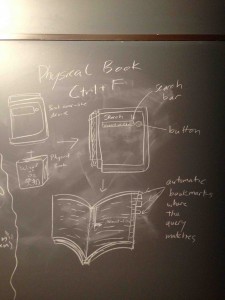
- Kinect phantom limb therapy – Kinect could be used to display missing body parts in the mirror image of a user, helping ease phantom limb pain.
- “Intelligent mirror” – Kinect system + screen would allow users to virtually try on all of the clothes in a store’s inventory
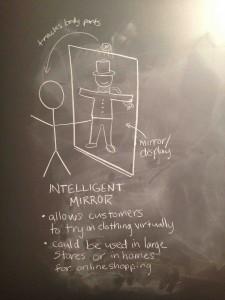
- Kinect-based application that allows the user to turn their entire body into a musical instrument – e.g. control volume by opening mouth while playing out pitches with arm position – but user could select which parts of their body they wanted to control which elements of the music.
- Sonar glove (or infrared glove) – a glove which emits and records a high-frequency sound (or infrared beam), indicating the distance from an obstacle via vibrations and allowing blind users to detect obstacles in front of them.
After much discussion, we finally decided upon idea #51, the “sonar-glove” (which may or may not actually employ sonar!) First and foremost, we believed that it would be a product that could completely change the way that the user base (the visually handicapped) faces its daily problems. By being something as inconspicuous as a glove, it would serve the same basic goal as a cane, but would draw much less attention and be far more convenient. By offering an analog scale of vibration frequency, users could know exactly how far away they were from an object, and if they wanted, they could even use more than one in order to scan even greater regions of space around them. Another advantage to this system is its design flexibility. While the idea was originally proposed as a glove, the same system could take the form of a more conventional cane (allowing the propioceptive benefits of this more standard approach), or even be embedded in the users shoes. Similarly, we began by thinking in terms of sonar, but have already begun discussing the advantages and disadvantages of other approaches (i.e. infrared beams). We believe that this idea will allow us to make the most of the experience of iterative design, while realistically culminating in the creation of a prototype that could be nothing short of miraculous for its users.
Target User Group: Our main target user group is the blind and visually handicapped. Of course, there are many other possible applications for this technology (working in dark spaces, assisting patients recovering from eye surgery, etc.), but the blind face daily challenges that make even the most basic of tasks frustrating, not the least of which is simply navigating their environment. As evidenced by the fact that multiple coping strategies already exist (canes, seeing-eye dogs, etc.), safely traversing the world is a demanding task for the visually handicapped – one we believe would be much alleviated by constantly being able to sense the distance of obstacles. Of course, while this is a user group which is not terribly common on Princeton’s campus, we believe it would be perfectly feasible to get user feedback by reaching out to hospitals, assisted-living homes, or other members in the nearby community. We believe it is important for users who actually understand the struggles of a visual handicap to test the system, so we will not simply allow testing to consist of “closing one’s eyes.”
Problem Description: The visually handicapped often use canes or other aids in order to walk about without fear of tripping or walking into an unseen obstacle. While effective, the cane provides a limited amount of information-the device does not alert the user to an obstruction until they are within a few feet of it, and the information refresh rate of the cane is limited by the speed with which the user can physically sweep it. What’s more, the cane is noisy and physically intrusive, and can become entangled in objects or other pedestrians. Our glove would serve instead of or in addition to a cane, and would provide more information while being less
Technical platform: Our technological platform of choice is the Arduino. We chose this because our device needs to be portable and needs to be able to make use of input from the proximity sensors and to control the vibration motors on the glove. It also does not require much computational power. The Arduino would also make it easier for us to quickly iterate on technical parameters of the device such as the sensitivity of the proximity detectors or the intensity of the vibration motors to provide the optimal user experience.

